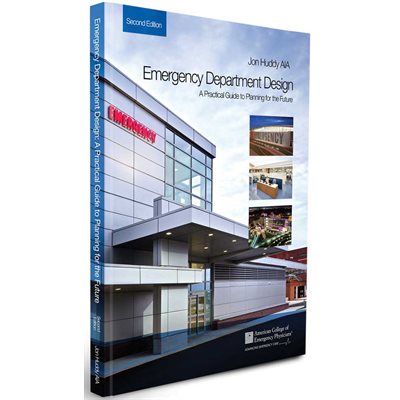- Sign In
-
- Some services are not accessible on smartphone
- Quick Order
My Cart - Quick Order
Emergency Department Design: A Practical Guide to Planning for the Future, 2nd Ed.

Product Code: 516615
- Develop economically sound solutions and deliver more with fewer resources
- Think beyond traditional design concepts and lead with step-by-step instructions, planning guidelines and tools.
- 27 case studies illustrate how modern design concepts have been applied to Ed projects of various size, complexity and scope.
Get perspectives on key issues:
- Physician leadership – the role of the emergency physician in the design process
- Steps in the design process
- Goal-setting and needs assessment – and space programming
- Selecting and working with consultants
- Putting the pieces together and planning for the future
- All the unique content you won’t find anywhere else – the design and construction process demystified with you in mind
REVIEWS
"In designing effective emergency departments, we are called to be both physician and architect, both scientist and poet. To achieve this, we must ask the right questions. This book is an excellent place to begin."—Tracy G. Sanson, MD, FACEP
"It provides insights that guide and instruct the reader on everything from the development of the ED project leadership team through project completion. The text is unique in that it communicates with the insights of an emergency physician yet with the precision and experience of a veteran architect." —Steven H. Mitchell, MD
About the Author
 |
Jon Huddy, AIA, as of the publishing of this book, has participated in the analysis, planning, and design of more than 325 emergency departments … and counting. His emergency department design experience includes projects across the United States, Canada, South America, and Europe. While an architect by training, his emergency department design experience includes a deep understanding of strategic planning, technology integration and how the physical environment can be shaped to support lean operations; allow for efficient staffing and provider coverage; keep the staff and patients safe; and help deliver successful outcomes that result in elevated patient and staff satisfaction scores. His designs have accommodated emergency departments as small as 6,000 annual visits in rural areas and complex medical center emergency departments as large as 200,000 visits. One of his greatest attributes is the ability to bring alternative operational and physical design solutions to his clients by drawing on his international emergency department design experience. As president of Huddy HealthCare Solutions, LLC, a firm focused on the specialty of emergency department consulting and design, he personally leads each emergency department engagement, whether it be for emergency department strategic planning, operational assessment, master planning, and/or architectural design services. Mr. Huddy has been designing health care facilities since earning a Master of Architecture degree from the Clemson University Architecture for Health Studio in the mid-1980s. He also completed the American Institute of Architects/American Hospital Association Graduate Fellowship in Health Facility Design. |
Since the early 1990s, Mr. Huddy has focused on the specialty of emergency department consulting and design and has teamed with hundreds of hospitals, physician groups, architects, and builders to deliver successful emergency department design solutions. Mr. Huddy is a member of the American Institute of Architects and is licensed by the National Council of Architectural Registration Boards. He has written several articles and delivered numerous international presentations and educational sessions on a wide range of topics, including “ED Vision 2030,” “Designing More (ED) with Less (Capital),” and “Designing Safe and Secure Emergency Departments.” Many of the items and issues from these presentations are presented in this book. His audiences have included the:
• American College of Emergency Physicians (ACEP, US)
• American Organization of Nurse Executives (AONE, US)
• American Society for Healthcare Engineering (ASHE, US)
• Center for Health Design (CHD, US)
• Emergency Nurses Association (ENA, US)
• European Society of Emergency Nurses (EuSEN)
• Health Estates & Facilities Management Association (HefmA, UK)
• Institute of Healthcare Engineering and Estate Management (IHEEM, UK)
• National Ergonomics Conference (US)
• Scottish Health Conference (UK)
• Health and Care Infrastructure Research and Innovation Centre (HaCIRIC, UK)
• International Emergency Department Leadership Institute (IEDLI)
“Huddy,” as he has been known since grade school, brings a passion for emergency department design, a commitment to including caregivers throughout the design process, and a humorous, energetic presentation style that has allowed him to develop close and lasting relationships with emergency department caregivers around the world. His unique insights, depth of experience, and impressive track record of successful emergency department design projects are the building blocks from which he has written this text.
Huddy is very interested in hearing about your unique design solutions to the challenges you face in creating your emergency department of the future. He can be reached at 803-517-7522 or j.huddy@huddyhealthcare.com.
About the Editor

Dr. Sanson has served in several and varied leadership positions with the Society for Academic Emergency Medicine (SAEM), the Council of Residency Directors (CORD), and the American College of Emergency Physicians (ACEP). She chairs the College’s Educational Meetings Subcommittee and is a member of the ACEP Speaker’s Bureau and the 911 network. She has been a member of the ACEP faculty for many years, including the ACEP Teaching Fellowship and the Emergency Department Directors Academy. Dr. Sanson received the National Emergency Medicine Faculty Teaching Award in 2006.
Tracy has held director positions with the US Air Force, the University of South Florida, and TeamHealth for the past 20 years. She completed her medical degree and residency training at the University of Illinois at Chicago. She has served on TeamHealth’s Medical Advisory Board, Patient Safety Office Division, and as faculty in their leadership courses. Dr. Sanson heads her own consulting firm, specializing in emergency department team and satisfaction assessments, leadership training, personal development/coaching, and branding. She has consulted and lectured nationally and internationally on administrative and management issues, leadership, professionalism, communication, patient safety, brand development, personal development, women’s issues, and emergency medical clinical topics for a wide range of health care organizations.
James Lennon, AIA
Michael Pietrzak, MD
David Vincent, AIA, ACHA, LEED AP
Table of Contents
Chapter 1 An Architect’s Retrospective
Chapter 2 Preparing to Lead and Internal Team-Building
Chapter 3 Project Delivery Options and Selecting Your Consultants, Designers, and Builders
Chapter 4 Project Justification and Needs Assessment
Chapter 5 Scope Definition
Chapter 6 The Design Puzzle: Pieces and Parts
Chapter 7 Design Components, Configurations, and Considerations
Chapter 8 Insights for Specialty Emergency Departments
Chapter 9 Wrap-Up – Imagine an Emergency Care Environment in the Distant Future
PART TWO CASE STUDIES
Case Study 1 Anne Arundel Medical Center, Emergency Department
Case Study 2 Bayhealth Medical Center, Kent General Pavilion Emergency Department
Case Study 3 CGH Medical Center, Emergency Department
Case Study 4 Charleston Area Medical Center, Memorial Hospital Emergency Department
Case Study 5 Concord Hospital, Emergency Department
Case Study 6 CoxHealth South, Emergency Department
Case Study 7 Le Bonheur Children’s Hospital, Emergency Department
Case Study 8 Lenox Health Greenwich Village, Freestanding Emergency Department
Case Study 9 Massachusetts General Hospital,Emergency Department
Case Study 10 Massachusetts General Hospital, Lunder Building Emergency Department iv Emergency Department Design
Case Study 11 MedStar Washington Hospital Center, Project ER One
Case Study 12 Memorial Hermann Northwest Hospital,Emergency Department
Case Study 13 Methodist Dallas Medical Center,Emergency Department
Case Study 14 Methodist University Hospital, Emergency Department
Case Study 15 Ohio Health Westerville, Freestanding Emergency Department
Case Study 16 Penn State Hershey Medical Center, Emergency Department
Case Study 17 Saint Francis Hospital, Trauma Emergency Center
Case Study 18 Southwest General Health Center, Emergency Department
Case Study 19 Stafford Hospital, Mary Washington Healthcare, Emergency Department
Case Study 20 Tampa General Hospital, Emergency and Trauma Center
Case Study 21 United Hospital, Peter J. King Emergency Care Center
Case Study 22 University Hospital of Bern, Intensive Care, Emergency Center, Operational Center
Case Study 23 University of Colorado, Emergency Department
Case Study 24 University of Colorado Health, Greeley Emergency and Surgery Center
Case Study 25 University of Michigan Hospital and Health Centers, Emergency Critical Care Center
Case Study 26 University of Pittsburgh Medical Center, Mercy Hospital Emergency Department
Case Study 27 University of Texas MD Anderson Cancer Center, Emergency Center
Title: Emergency Department Design: A Practical Guide to Planning for the Future
Author: Jon Huddy
Editor: Tracy G. Sanson
Publication Date: 2016
Page Count: 448
Format: eBook (Kindle + ePub)
Edition: Second
Print ISBN: 978-0988997356
EISBN: 978-0998891217
"In designing effective emergency departments, we are called to be both physician and architect, both scientist and poet. To achieve this, we must ask the right questions. This book is an excellent place to begin."—Tracy G. Sanson, MD, FACEP
"It provides insights that guide and instruct the reader on everything from the development of the ED project leadership team through project completion. The text is unique in that it communicates with the insights of an emergency physician yet with the precision and experience of a veteran architect." —Steven H. Mitchell, MD
Click here to read a full review by Steven H. Mitchell, MD

